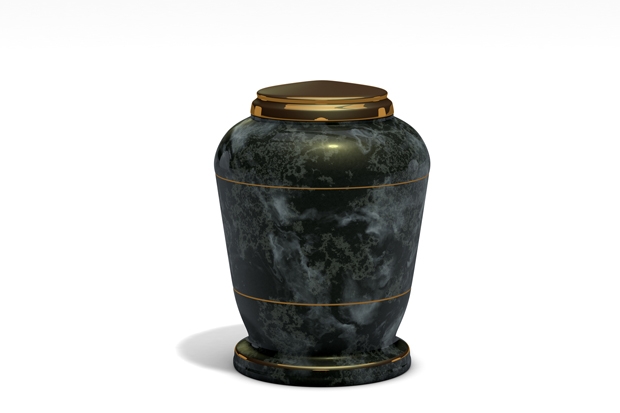Most people who die in Britain are now cremated — more than 70 per cent of them — but there is often uncertainty among the bereaved about what to do with the ashes. When dead bodies aren’t burnt, it is straightforward: they are buried in coffins. But the options for the ashes of the dead are various. They may be interred in a churchyard or a cemetery, they may be planted among the roots of a new tree, and they may be scattered in the countryside, in a river, or at sea.
But these are just the conventional choices. Lots of exotic alternatives are also offered. One website about the disposal of ashes offers 27 options: launching into space, using in firework displays, floating up into the atmosphere in helium balloons, making into diamonds, mixing in paint, turning into pencil fillings, pressing into vinyl records, and so on. Two stranger choices are using the ashes in a hourglass (‘Though the glass won’t be a reliable timepiece, it will be a beautiful item on the mantelpiece’), and putting them into bullets (‘Your body may be gone, but you don’t have to miss next year’s hunting trip’).
One of the dangers with having such a range of choices is that you can end up doing nothing at all. Both my parents were cremated. My father, who died in 1989, had his ashes buried in the family plot in Lanarkshire, but those of mother, who died nine years later, have still so far to find a resting place, having been in the custody of one and then another of her devoted children. Uncertainty about when and where to bury them is to blame for the delay.
The rules are pretty lax about what you may do with the remains of a cremated body, but there was a catastrophic misjudgment recently reported from New York. A Dallas opera lover scattered a friend’s ashes in the orchestra pit of the Metropolitan Opera, causing a terrorism scare and forcing the company to cut short one performance of a Rossini opera and to cancel another, costing it thousands of dollars. It was feared that the white powder thrown into the pit could have been a dangerous substance such as anthrax.
The man responsible, Roger Kaiser, wrote a letter of apology to Peter Gelb, the Met’s general manager. He shared a passion for opera with his friend Terry Turner, with whom he had discussed the ash-scattering idea in 2012 when Terry was dying of cancer. ‘I told Terry that if he would like, I would take some of his ashes to opera houses that I visited in the future,’ he wrote. ‘I jokingly told Terry they would never be able to vacuum all of him up. He would be there for ever enjoying the beautiful music.’
‘That is what this was,’ Kaiser continued. ‘A sweet gesture to a dying friend that went completely and utterly wrong in ways that I could never have imagined. If I had ever thought anything like this could happen, I would never have done it.’ In his reply Mr Gelb accepted this ‘heartfelt apology’ for the disturbance, but pointed out that it had nevertheless ‘caused the members of our company several anxious hours, severely disappointed our audiences, and cost the Met, its artists and the city many thousands of dollars’.
So this is clearly not the way to go. I would personally like to be cremated and have my ashes buried in a churchyard, but there can be problems with this, too. Some churches relegate people’s ashes to a small section of a churchyard with only tiny gravestones, like a pets’ burial ground. This was what happened to my brother’s ashes this year, though his stone is admittedly in a pleasant spot, isolated from the others. I don’t see why cremated people should be less grandly commemorated than those who are not.
These thoughts crossed my mind after the especially touching funeral service in Dorset of a splendid, good and clever friend, Bill Debenham, who was suddenly taken away by cancer. He had no religion, but the service was without a vicar in a beautiful little deconsecrated church and consisted of tributes, readings and music. By his wish, his ashes will be scattered on a beautiful stretch of Dorset countryside where he lived. It is a good way to be going.






Comments